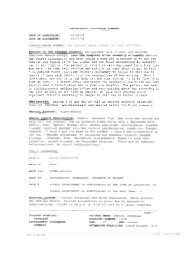C - Organized Mobbing
C - Organized Mobbing
C - Organized Mobbing
Create successful ePaper yourself
Turn your PDF publications into a flip-book with our unique Google optimized e-Paper software.
504<br />
CHAPTER NINE<br />
P as evidenced by their high-handed clandestine meeting with the foreign<br />
peace activist. As insinuated by the anonymous letter, this meeting reve aled<br />
significant asymmetries of information (and by implication: power) in th e<br />
group. Tellingly, the letter also took position against considerations floatin g<br />
around at that time to associate the group more formally with the Protestant<br />
Church in an effort to better protect its members from Stasi actions. ?his<br />
was controversial in the group as it was clear to most members-who were<br />
overwhelmingly secular in orientation-that activities planned and con-<br />
ducted under the auspices of the church were once more subject to authori-<br />
tative approval and de facto restricted by the church's complicated compact<br />
with the party state.<br />
On February 16,1984, Lieutenant Jager of the department 2 of the minis-<br />
try's division XX, the likely author of this measure of decomposition and the<br />
guidance officer of secret informant Monika Hager, wrote a report about a<br />
meeting with her in which he characterized the effect of the letter on three<br />
members of the group who had met two days earlier in Beate Harembskys<br />
apartment. iV1 four participants (especially the three not working on be-<br />
half of the Stasi) are depicted as agreeing with the basic propositions of<br />
the anonymous letter. The officer describes how the informant (the likely<br />
coauthor of the letter) chimed in with this sentiment by calling the dynamics<br />
of the group as having arrived "at ground zero." Through this recognizing<br />
intervention, she thus nudged the interaction even further in the direction<br />
of the result desired by the Stasi. The offcer claims that the conversations<br />
of the evening and the letter have encouraged the three women to seek an<br />
open confrontation with Poppe and Bohley during one of the next meetings.<br />
The report concludes:<br />
The source [i.e., the informant Hager] is of the opinion that the letter's con-<br />
tent and time of distribution will probably deepen the extant contradictions<br />
in the women's group.<br />
In other words, the guidance officer and his informant are reporting an<br />
emergent success of an implemented measure of decomposition to the<br />
higher-ups in the Stasi hierarchy.<br />
Nine days later, on February 25,1984, officer Jager reports about a report35<br />
of his informant about a conversation she had the day before with Ulrike<br />
35. Although the language in what follows may sound awkward, it is important to keep in mind<br />
to which degree the case officers were actually removed from the persons they investigated.<br />
Sometimes it would be tempting to add a little number in superscript to the verb "to report"<br />
in order to indicate through how many links a particular occurrence was reported. TO say in<br />
this notation, if an informant reports' (that is, something he or she has directly witnessed), the<br />
guidance officer reports2 and the case officer or analyst summarizing these reports2 actually





